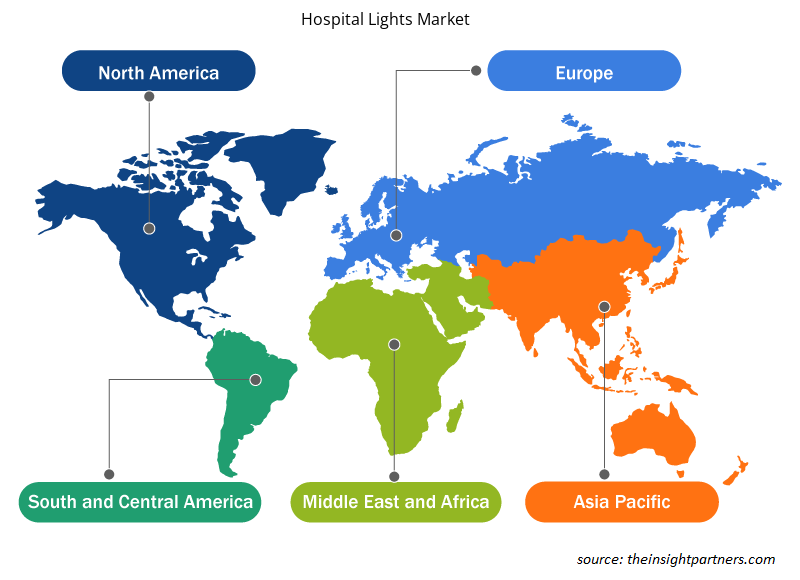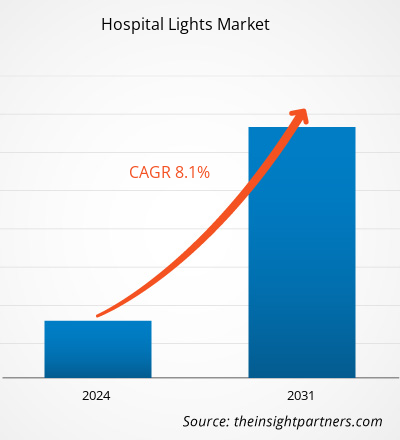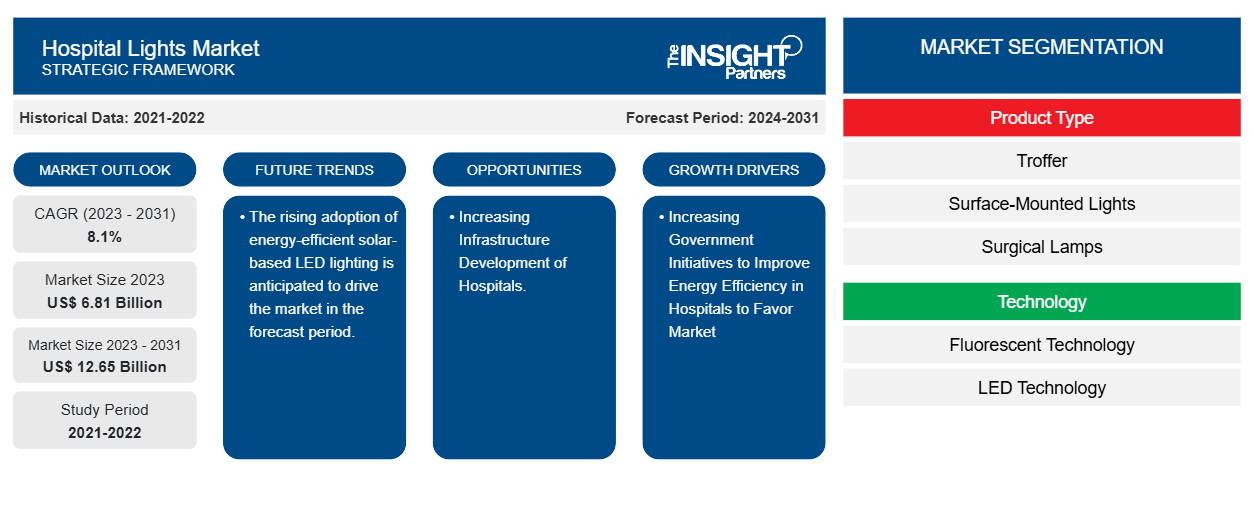Se proyecta que el tamaño del mercado de iluminación hospitalaria alcance los 12.650 millones de dólares estadounidenses en 2031, frente a los 6.810 millones de dólares estadounidenses en 2023. Se espera que el mercado registre una CAGR del 8,1 % durante el período 2023-2031. Es probable que las crecientes iniciativas gubernamentales para mejorar la eficiencia energética en los hospitales y la alta demanda de luces LED durante las cirugías sean tendencias clave y factores impulsores del mercado de iluminación hospitalaria.
Análisis del mercado de iluminación para hospitales
El mercado de iluminación hospitalaria está experimentando un crecimiento significativo a nivel mundial. Este crecimiento se atribuye a factores como las crecientes iniciativas gubernamentales para mejorar la eficiencia energética en los hospitales y la alta demanda de luces LED durante las cirugías. Además, se prevé que el creciente desarrollo de la infraestructura de los hospitales y la creciente adopción de iluminación LED solar de bajo consumo energético ofrezcan varias oportunidades para el mercado de iluminación hospitalaria.
Descripción general del mercado de iluminación para hospitales
La iluminación hospitalaria se define como la iluminación artificial de instalaciones sanitarias, como clínicas, hospitales, residencias de ancianos, etc. La iluminación hospitalaria se puede dividir en dos categorías principales: iluminación interior e iluminación exterior.
Personalice este informe según sus necesidades
Obtendrá personalización en cualquier informe, sin cargo, incluidas partes de este informe o análisis a nivel de país, paquete de datos de Excel, así como también grandes ofertas y descuentos para empresas emergentes y universidades.
-
Obtenga las principales tendencias clave del mercado de este informe.Esta muestra GRATUITA incluirá análisis de datos, desde tendencias del mercado hasta estimaciones y pronósticos.
Impulsores y oportunidades del mercado de iluminación para hospitales
Aumentar iniciativas gubernamentales para mejorar la eficiencia energética en los hospitales para favorecer el mercado.
El aumento de las iniciativas gubernamentales para mejorar la eficiencia energética en los hospitales impulsa el crecimiento del mercado a nivel mundial. La iluminación juega un papel crucial en las instalaciones médicas. No se trata solo de proporcionar luz para la visibilidad, la iluminación del hospital afecta al bienestar de los pacientes, la eficiencia de los profesionales médicos y el ambiente general del hospital. Para este bienestar, los gobiernos de varios países e iniciativas. Por ejemplo, en febrero de 2022, el Gobierno de la India buscó introducir hospitales ecológicos y digitales con la misión de ahorrar energía y transformar el sector de la salud. En esta iniciativa, el gobierno reemplazó 33.000 luces convencionales por luces LED para obtener mejores niveles de lux y ahorro de energía. Por lo tanto, considerando los factores anteriores, varias iniciativas gubernamentales para mejorar la eficiencia energética en los hospitales están impulsando el mercado de iluminación hospitalaria.
Incrementar el desarrollo de la infraestructura hospitalaria.
Se prevé que el creciente desarrollo de la infraestructura genere varias oportunidades para el mercado de iluminación hospitalaria. A medida que mejora la infraestructura del hospital, también aumenta la demanda de suministros hospitalarios y eficiencia energética. Además, muchos países están invirtiendo en el desarrollo de la infraestructura hospitalaria. Por ejemplo, en marzo de 2024, la financiación federal impulsó mejoras masivas de la infraestructura sanitaria en Estados Unidos. Los próximos proyectos importantes de instalaciones médicas requerirán varios tipos de experiencia en la industria, así como una gran cantidad de equipos, componentes de seguridad y tecnología. Por lo tanto, se prevé que el gobierno tome varias iniciativas para impulsar el mercado de iluminación hospitalaria.
Análisis de segmentación del informe de mercado de luces de hospital
Los segmentos clave que contribuyeron a la derivación del análisis del mercado de luces de hospital son el tipo de producto, la tecnología y la aplicación.
- Según el tipo de producto, el mercado de lámparas para hospitales se divide en lámparas de pie, lámparas de superficie, lámparas quirúrgicas y otras. Se prevé que el segmento de lámparas de pie tenga una cuota de mercado significativa en el período de previsión.
- Según la tecnología, el mercado de iluminación para hospitales se divide en tecnología fluorescente, tecnología LED y otras. Se prevé que el segmento de tecnología fluorescente tenga una participación de mercado significativa en el período de pronóstico.
- Por aplicación, el mercado se segmenta en salas de pacientes y UCI, quirófanos, salas de examen y otros. Se prevé que el segmento de salas de pacientes tenga una participación de mercado significativa en el período de pronóstico.
Análisis de la cuota de mercado de las luces de hospital por geografía
El alcance geográfico del informe del mercado de luces de hospital se divide principalmente en cinco regiones: América del Norte, Asia Pacífico, Europa, Medio Oriente y África, y América del Sur y Central.
América del Norte ha dominado el mercado de iluminación hospitalaria. El crecimiento del mercado de iluminación hospitalaria está experimentando un crecimiento debido a las crecientes iniciativas gubernamentales para mejorar la eficiencia energética en los hospitales y la alta demanda de luces LED durante las cirugías en la región. Además, un fuerte énfasis en la investigación y el desarrollo en las economías desarrolladas de los EE. UU. y Canadá está obligando a los actores norteamericanos a traer soluciones tecnológicamente avanzadas al mercado. Además, EE. UU. tiene un gran número de actores del mercado de iluminación hospitalaria que se han centrado cada vez más en el desarrollo de soluciones innovadoras. Todos estos factores contribuyen al crecimiento del mercado de iluminación hospitalaria en la región.
Perspectivas regionales del mercado de iluminación para hospitales
Los analistas de Insight Partners explicaron en detalle las tendencias y los factores regionales que influyen en el mercado de iluminación para hospitales durante el período de pronóstico. Esta sección también analiza los segmentos y la geografía del mercado de iluminación para hospitales en América del Norte, Europa, Asia Pacífico, Oriente Medio y África, y América del Sur y Central.

- Obtenga datos regionales específicos para el mercado de iluminación de hospitales
Alcance del informe de mercado de iluminación para hospitales
| Atributo del informe | Detalles |
|---|---|
| Tamaño del mercado en 2023 | 6.810 millones de dólares estadounidenses |
| Tamaño del mercado en 2031 | US$ 12,65 mil millones |
| CAGR global (2023 - 2031) | 8,1% |
| Datos históricos | 2021-2022 |
| Período de pronóstico | 2024-2031 |
| Segmentos cubiertos |
Por tipo de producto
|
| Regiones y países cubiertos |
América del norte
|
| Líderes del mercado y perfiles de empresas clave |
|
Densidad de actores del mercado: comprensión de su impacto en la dinámica empresarial
El mercado de iluminación para hospitales está creciendo rápidamente, impulsado por la creciente demanda de los usuarios finales debido a factores como la evolución de las preferencias de los consumidores, los avances tecnológicos y una mayor conciencia de los beneficios del producto. A medida que aumenta la demanda, las empresas amplían sus ofertas, innovan para satisfacer las necesidades de los consumidores y aprovechan las tendencias emergentes, lo que impulsa aún más el crecimiento del mercado.
La densidad de actores del mercado se refiere a la distribución de las empresas o firmas que operan dentro de un mercado o industria en particular. Indica cuántos competidores (actores del mercado) están presentes en un espacio de mercado determinado en relación con su tamaño o valor total de mercado.
Las principales empresas que operan en el mercado de iluminación hospitalaria son:
- Significar la celebración (Philips)
- Marcas Acuity, Inc.
- Iluminación Cree
- Dragerwerk AG & Co. KGaA
- Grupo KLS Martin
- Corporación Stryker
Descargo de responsabilidad : Las empresas enumeradas anteriormente no están clasificadas en ningún orden particular.

- Obtenga una descripción general de los principales actores clave del mercado de luces de hospital
Noticias y desarrollos recientes del mercado de iluminación para hospitales
El mercado de iluminación hospitalaria se evalúa mediante la recopilación de datos cualitativos y cuantitativos a partir de una investigación primaria y secundaria, que incluye publicaciones corporativas importantes, datos de asociaciones y bases de datos. A continuación, se enumeran algunos de los avances en el mercado de iluminación hospitalaria:
- Royal Philips, líder mundial en tecnología sanitaria, ha anunciado una alianza estratégica para integrar la solución avanzada de smartQare, viQtor, con las plataformas de monitorización clínica de pacientes de Philips, líderes a nivel mundial. Esta colaboración tiene como objetivo hacer posible la próxima generación de monitorización continua de pacientes tanto dentro como fuera del hospital, comenzando en Europa. (Fuente: Sitio web de la empresa Royal Philips, abril de 2024)
Informe de mercado sobre iluminación de hospitales: cobertura y resultados
El informe “Tamaño y pronóstico del mercado de luces de hospital (2021-2031)” proporciona un análisis detallado del mercado que cubre las siguientes áreas:
- Tamaño del mercado de iluminación de hospitales y pronóstico a nivel global, regional y nacional para todos los segmentos clave del mercado cubiertos bajo el alcance
- Tendencias del mercado de iluminación para hospitales, así como dinámicas del mercado, como impulsores, restricciones y oportunidades clave
- Análisis detallado de las cinco fuerzas de Porter y PEST y FODA
- Análisis del mercado de iluminación para hospitales que cubre las tendencias clave del mercado, el marco global y regional, los principales actores, las regulaciones y los desarrollos recientes del mercado
- Análisis del panorama de la industria y de la competencia que abarca la concentración del mercado, el análisis de mapas de calor, los actores destacados y los desarrollos recientes en el mercado de iluminación para hospitales
- Perfiles detallados de empresas
- Análisis histórico (2 años), año base, pronóstico (7 años) con CAGR
- Análisis PEST y FODA
- Tamaño del mercado, valor/volumen: global, regional y nacional
- Industria y panorama competitivo
- Conjunto de datos de Excel
Informes recientes
Informes relacionados
Testimonios
Razón para comprar
- Toma de decisiones informada
- Comprensión de la dinámica del mercado
- Análisis competitivo
- Información sobre clientes
- Pronósticos del mercado
- Mitigación de riesgos
- Planificación estratégica
- Justificación de la inversión
- Identificación de mercados emergentes
- Mejora de las estrategias de marketing
- Impulso de la eficiencia operativa
- Alineación con las tendencias regulatorias























 Obtenga una muestra gratuita para - Mercado de luces de hospital
Obtenga una muestra gratuita para - Mercado de luces de hospital